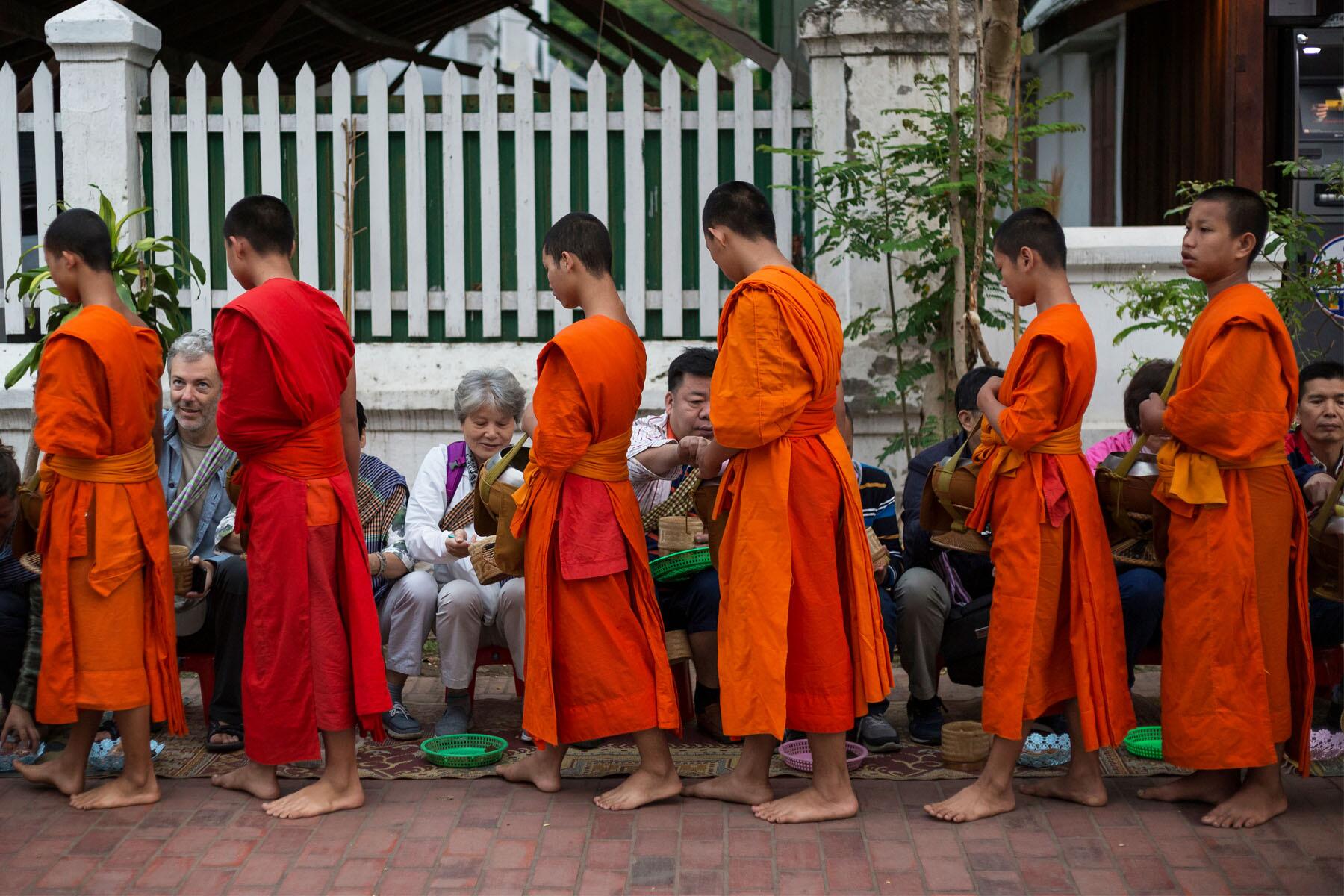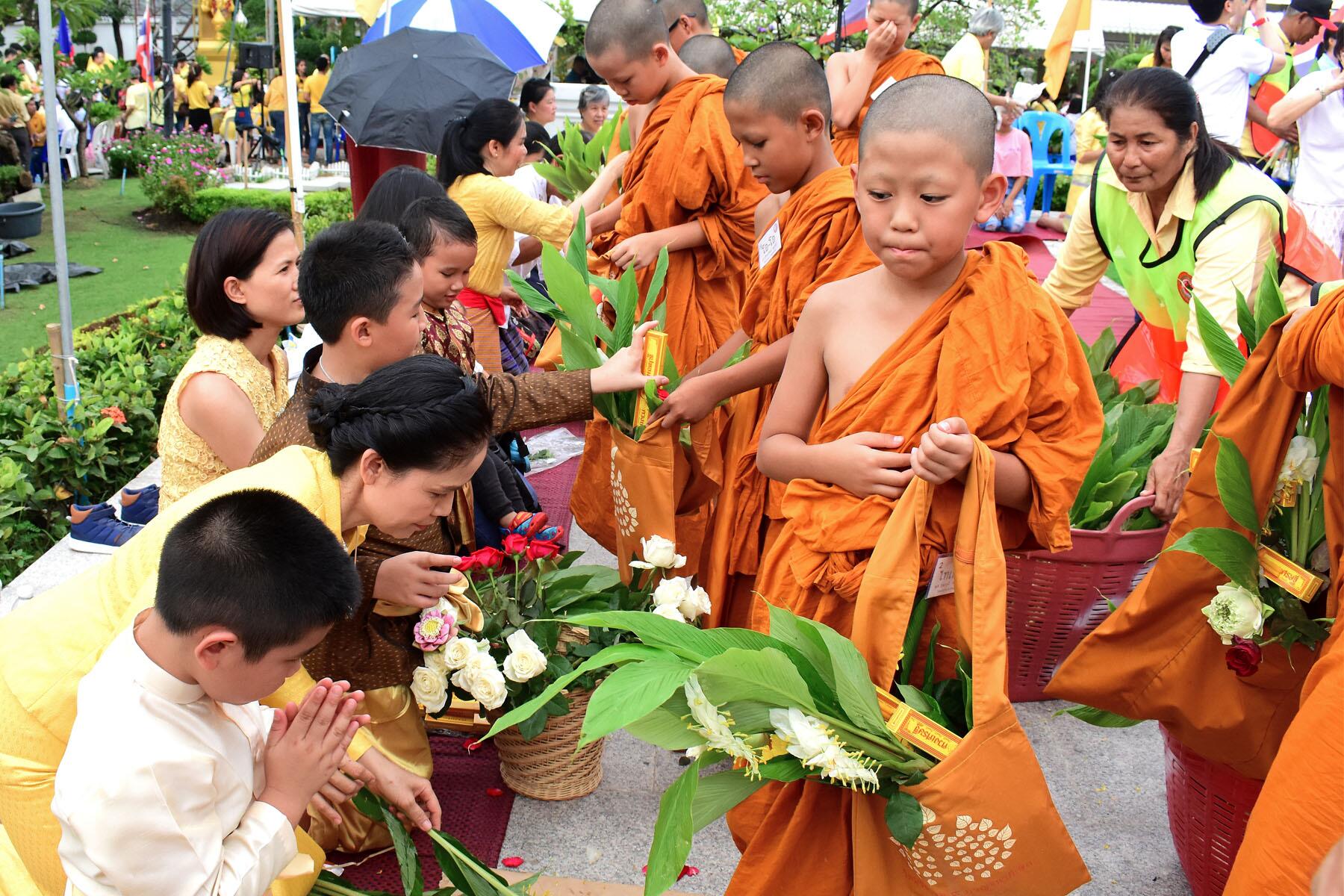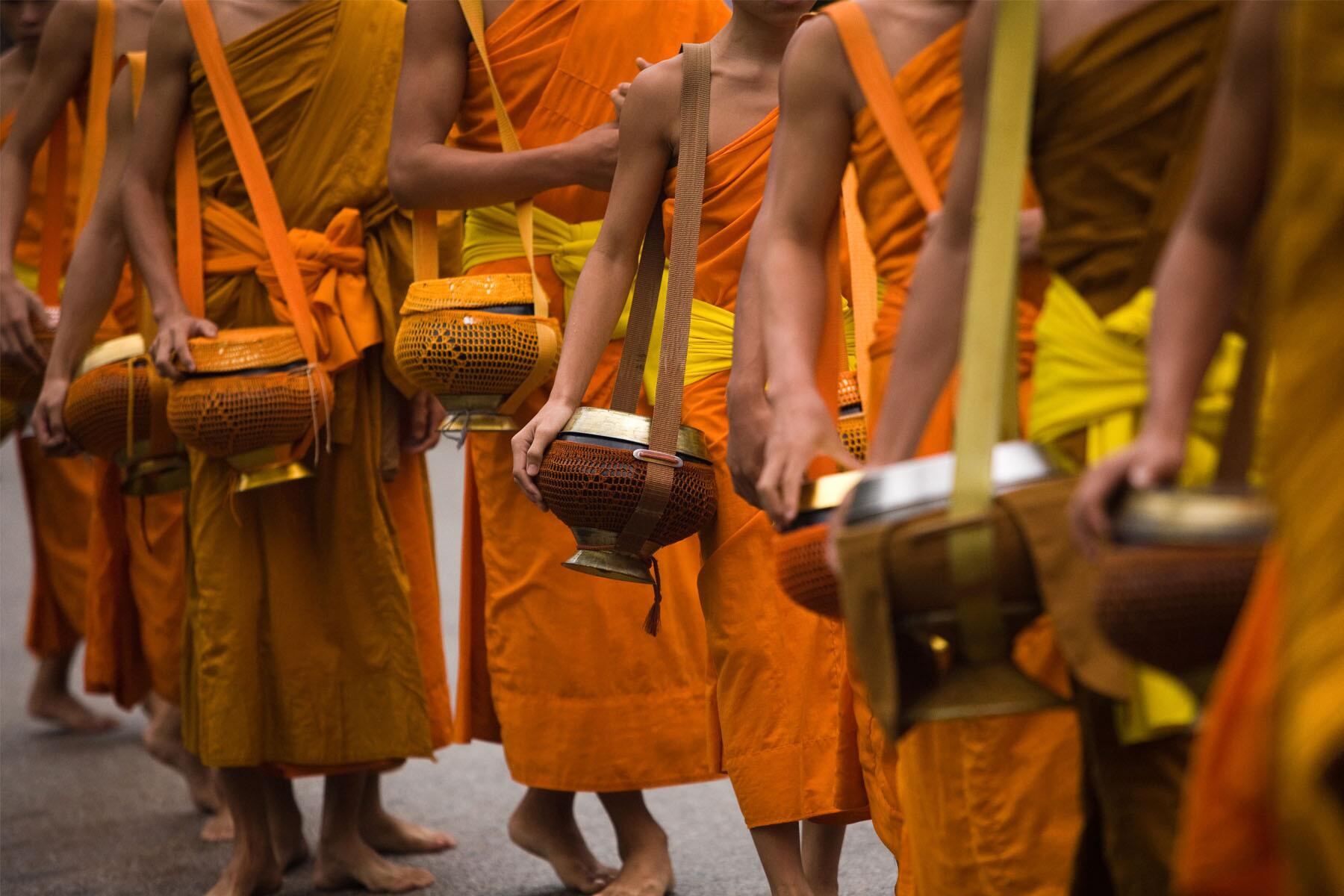Let's talk about the Buddhist Tak Bat ceremony in Luang Prabang and how not to screw it up.
Tourists have a reputation for behaving badly. It’s most often because we lack understanding of cultural norms and etiquette different from our own, but it’s because we think our photo-op or vacation experience is more important than the people going about their everyday lives in the countries we visit.
Luang Prabang, the ancient royal capital of Laos, sees bad tourists of both ilks. Here’s what you need to know when visiting Luang Prabang to ensure you’re not one of them.
The Tak Bat Ceremony and Why It Makes Luang Prabang so Popular
Every morning before sunrise, hundreds of monks leave their temples to walk the streets of Luang Prabang (that’s pronounced “Loo-ong Pra-bong”, by the way) to collect alms. They’re barefoot, dressed in robes of ochre and saffron, with metal bowls hanging from their shoulders. They walk in silence as a form of meditation. Kneeling, devout Buddhists reverentially place carefully-prepared sticky rice into their bowls. Called Tak Bat, this ritual is neither begging nor charity, but a spiritual connection for those that follow Theravada Buddhism.

Tak Bat takes place in every village and city with a Theravada Buddhist temple, whether in Bangkok, Siem Reap, or New York City. The ceremony is an integral part of Luang Prabang and is how this UNESCO World Heritage town became famous. Tourists come from neighboring countries and from all over the world to see, photograph, and experience Tak Bat. But their lack of understanding and respect is turning this sacred ritual into a forced performance in front of noisy, Instagram-fixated crowds who insult the residents of the town they’ve come to visit.
Recommended Fodor’s Video
The Commercialization of Tak Bat
Tak Bat has become a bit of an industry in Luang Prabang. Certainly, airlines, packaged tours, and hotels benefit from tourists’ interest, as do restaurants, shops, and activity operators when tourists stay for a few days and explore everything the area has to offer. Drivers drop off busloads of tourists in the UNESCO zone every morning. Some entrepreneurs, many from economically-at-risk villages nearby, have created a business selling the ceremony to tourists.
In theory, this isn’t necessarily a bad thing—lots of people around the world make money from religion. People need to make a living, especially in a country like Laos where, according to the United Nations, 80 percent of citizens live at risk of poverty on no more than $2.50 USD/day.

However, the practice of Tak Bat in Luang Prabang is becoming increasingly detrimental. Buses, often left idling, break the silence and pollute the air. Entrepreneurs rent out stools and mats for tourists to sit on. Some, presenting themselves as “helpers”, invite tourists to participate in the ceremony, only to put their hand out for $20 afterward. Few benefitting from the Tak Bat business—drivers, mat entrepreneurs, many hotels, even the students hired by the tourism board to police the ceremony—educate tourists on the rules and etiquette of Tak Bat, let alone correct bad behaviors. And there’s a lot of bad behavior.
Also problematic is the selling of food for tourists to give to monks. Much of what is sold hasn’t been stored or handled properly. Food poisoning was so frequent that monks break their meditation to discretely dump these food parcels into baskets as they walk, increasing waste and costs to the city to dispose of it. Merchants also hawk packaged foods like ramen noodles, though it’s against Tak Bat’s spiritual and practical purposes to give these to monks. The packaged food often ends up back in villages as donations, but the cycle wastes already-limited resources and perpetuates poverty.
Few benefitting from the Tak Bat business—drivers, mat entrepreneurs, many hotels, even the students hired by the tourism board to police the ceremony—educate tourists on the rules and etiquette of Tak Bat, let alone correct bad behaviors. And there’s a lot of bad behavior.
Tourists’ behaviors—which are barely deterred by people who do know better—are making Tak Bat stressful for monks, worshippers, and, increasingly, for tourists who worry about the damage. Residents have periodic discussions with the tourism board about discontinuing the ritual and hotels provide varyingly detailed information sheets, but little improves.
For now, at least, Tak Bat remains a daily practice in Luang Prabang. But without the efforts of everyone involved, especially tourists, it will soon be nothing more than a Disney show. Want to help protect this beautiful tradition? Here’s what you need to know.
How to Respectfully Observe Tak Bat
If you think about the ceremony as though it were taking place inside a church or temple rather than on the streets, your instincts of what is appropriate should kick in. Follow that general guideline with these few additional rules.
- Don’t interfere with the ceremony in any way.
- Observe in silence. If you must communicate, whisper and keep it brief. If you’ve seen enough and want advice on which waterfall to visit, go to a restaurant and discuss over croissants or the Lao version of pho.
- Shake your head “no” if any Tak Bat entrepreneurs approach you; don’t break the silence by talking to them.
- Keep your distance. Stay the recommended five yards away from worshippers and monks. Don’t touch monks or their clothing. Never block the path of monks and don’t walk through their procession (there will be occasional large gaps between groups of monks; wait for one if you need to cross the street).
- Keep your camera flash—and sounds—off. And let’s repeat: keep your distance. Don’t take close-ups of any participants. And we don’t have to explicitly state “no selfies”, do we?
- Don’t make eye contact with participants—you’re breaking their focus on their meditations.
- Dress respectfully. Showing too much skin at any time tends to embarrass people in Buddhist countries like Laos. Whether observing or participating in Tak Bat, you should be covered from shoulders to knees. No hats either, please.
- Keep your head lower than the monks’. That means watching from street level, never from a bus, a hotel balcony, or by climbing on anything to get a better view.

Unless You’re a Practicing Buddhist (and Will Follow the Rules), Don’t Participate
Participating in Tak Bat is a religious ritual, not a tourist activity. While tour operators and hotels organize participation for their guests, please don’t do it unless you’re a practicing Buddhist and the ceremony has meaning to you.
If you do participate:
- Ensure you understand the nuances of the ritual and your role in it.
- Ask your hotel to prepare the sticky rice you’re offering. Don’t buy it on the street. Don’t give packaged goods or money.
- Wear respectful clothing, with knees and shoulders (and everything in between) covered. Remove your shoes and your hat. Wear a sash—good hotels will provide it and show you how to tie it.
- Don’t go to Sakkaline Road and contribute to the circus crowds. Your hotel should recommend a quieter spot.
- Kneel on a mat or sit on a low stool. Never raise your head higher than the monks’.
- Lower your head and your eyes when you put your offering into a monk’s bowl. Women should take extra care not to touch the monks’ robes.
- No photos of you while giving alms. If you absolutely must, the photographer should stay five yards away.
- Monetary donations to temples are welcome, but ask your hotel how to do it. Don’t put money into alms bowls.
With everyone’s efforts, the beauty and sacredness of Tak Bat and Luang Prabang can be preserved for the future.




